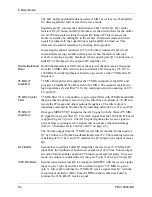
5: Mixer Board
5-4
PRC1099A-MS
The LO1 buffer and double-balanced mixer MX1 as well as the IF amplifier
U4 draw significant current levels in receive mode.
Squelch gate Q2 controls the current drain of LO1 buffer Q1. Q1 emitter
resistors R5 (47 ohms) and R4 (820 ohms) set the current draw for the buffer
circuit. When squelch is turned on, gate Q2 turns off. This increases the
emitter resistance by adding R4 to the emitter. In transmit mode and when
squelch is turned off, the squelch line is high and Q2 is turned on. This
decreases the emitter resistance by shorting R4 to ground.
Increasing the emitter resistance (47 to 867 ohms) reduces the Q2 circuit
current drain, saving valuable battery power when the radio is idle (not
actively receiving a signal). Similarly, when squelch gate Q13 is turned on, it
adds R67 (100 ohms) to the output of IF amplifier U4.
Double-Balanced
Mixer
Double-balanced mixer MX1 mixes the selected channel receive frequency
from the 30 MHz filter with the local oscillator LO1 frequency (76.597 to
105 MHz) from the Synthesizer board to up-convert to the 75 MHz first IF
frequency.
75 MHz IF
Amplifier 1
75 MHz IF amplifier U4 amplifies the 75 MHz output from the MX1 and
provides a broadband 50 ohm match to the MX1. The output is matched to
high impedance crystal filter Y1 by the matching network consisting of C17,
L5, and C18.
75 MHz Crystal
Filter
75 MHz filter Y1 is a monolithic, 4-pole crystal filter with 25 MHz bandwidth
that provides the primary selectivity. The filter has a stopband of -70 dB and
rejects the IF image and other spurious frequencies. The filter output is
impedance matched to 50 ohms by the matching network C44, L14, and C45.
75 MHz IF
Amplifier 2
Dual-gate MOSFET Q7 integrates the AGC signal with the filtered 75 MHz
IF signal from crystal filter Y1. The AGC signal from the 1650 kHz IF board
is applied to gate 2 (pin 3). The AGC signal regulates the receive signal to
prevent large incoming receive signals that can cause component damage
(refer to “Automatic Gain Control (AGC)” on page 4-3).
The 50 ohm output from the 75 MHz crystal filter is matched to the input of
Q7 by 50 ohm to 450 ohm broadband transformer T2. The matching network
consisting of C52, L18, and C53 matches the Q7 output to the input of mixer
Q8.
LO2 Buffer
Second local oscillator buffer Q10 amplifies the low level 73.35 MHz LO2
input from the Synthesizer board to an output level of 2 Vrms. Tuned output
circuit L20 and variable capacitor C58 insure good spectral purity. In receive
mode, the output is coupled directly into gate 2 (pin 3) of receiver mixer Q8.
1650 kHz Mixer
Second conversion mixer Q8 is a dual-gate MOSFET with the receive signal
input to gate 1 (pin 4) and the LO2 oscillator input (73.35 MHz) to gate 2
(pin 3). Mixer Q8 combines the 75 MHz IF receive signal from Q7 with the
second local oscillator (LO2) from the DDS on the Synthesizer board to
produce the 1650 kHz IF receive signal.






























